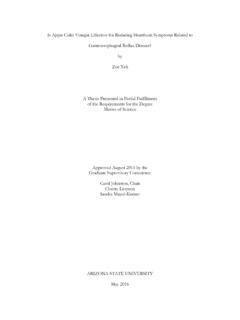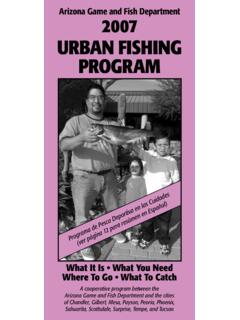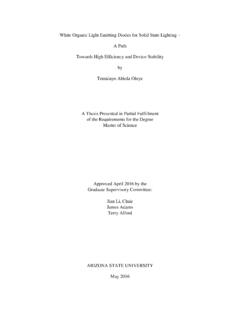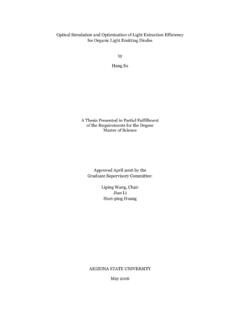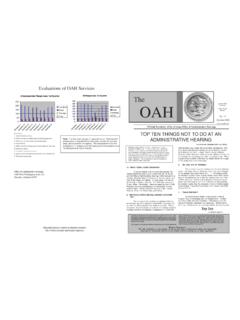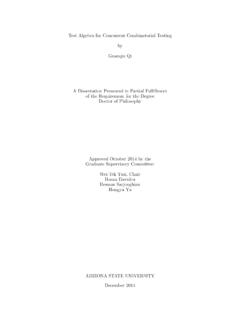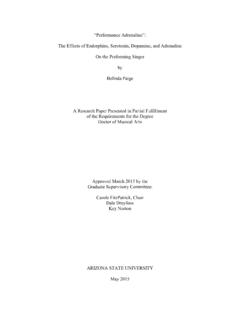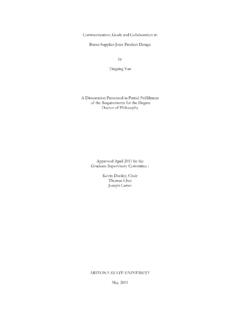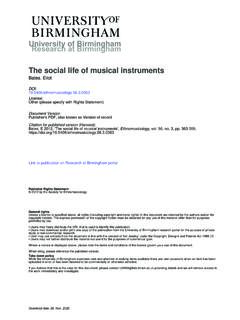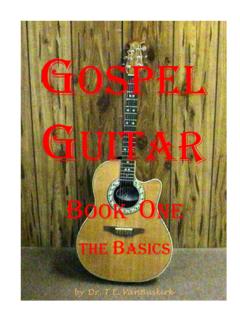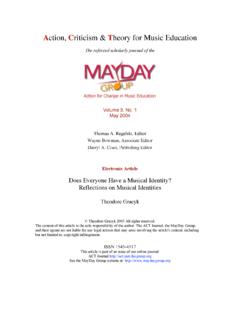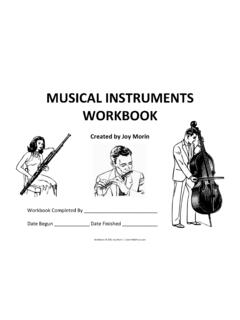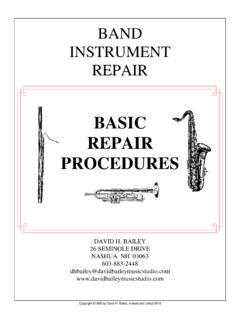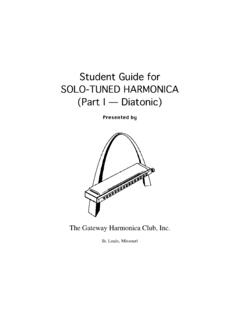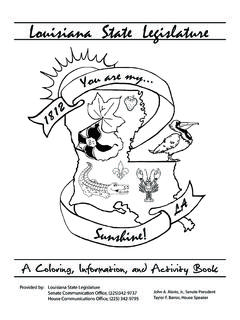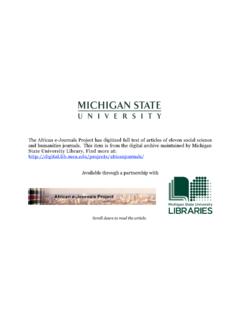Transcription of A Beginner Method Book for Oboists: A Proposal by William ...
1 A Beginner Method book for oboists : A Proposal by William Aikens A Research Paper Presented in Partial Fulfillment of the Requirements for the Degree Doctor of musical Arts Approved November 2014 by the Graduate Supervisory Committee: Martin Schuring, Chair Joshua Gardner Ellon Carpenter ARIZONA STATE UNIVERSITY December 2014 i ABSTRACT The purpose of this project was to create a Beginner -level oboe Method book that provides equal attention to both the instrumental and musical concepts necessary for a Beginner oboist. The existing literature for beginning oboe students focuses on two specific settings: full band classrooms, where students are playing and learning the instruments together, and private lesson settings, where one or a group of oboe students are focused on learning to play the oboe.
2 Books written for band settings typically focus on teaching the students how to function as a part of the band, with extensive coverage of musical concepts; conversely, books for private lessons often assume a basic level of musical knowledge by the student, and focus heavily on how to play the instrument. This project provides the basis for a new book that combines these elements into a document that both band and private instructors would be able to use. I began my project by collecting all of the extant Beginner -level Method books for the oboe, dividing them into those for band settings and those for lesson settings. I then created a detailed survey to analyze each book s contents so that in the new book I might address any and all shortcomings in the existing literature. I then distilled the results of this survey into charts, so that any teacher could look at the contents of each book and see how said book fits within the results.
3 Once this was finished, I created an outline for the new Method book , listing the contents of the front material, lessons, and back material. My outline sequences the musical and instrumental material together, providing students with all of information necessary to become a successful beginning oboist. I stopped short of selecting music or creating the book s layout, but my goal is to publish the completed book within the next year. ii ACKNOWLEDGMENTS First, I would like to thank Dr. Cindy Renander. Your research inspired the analysis that shaped this project, and I am very grateful that you allowed me to utilize your work. Many thanks my committee members, Dr. Gardner and Dr. Carpenter, for their help and advice throughout the course of this project. To Martin Schuring: thank you for not only serving as the chair of my supervisory committee, but for your guidance throughout my two and half years here at Arizona State.
4 You have helped me become a better player, reed maker, and teacher, and I am so grateful for your friendship and tutelage. Finally, to my wife Megan: thank you for supporting my decision to return to school, for encouraging me throughout this process, and for our beautiful son. iii TABLE OF CONTENTS Page LIST OF TABLES .. v LIST OF FIGURES .. vi CHAPTER INTRODUCTION .. 1 1 THE SURVEY .. 3 Choosing the 3 Creating an Objective Analysis of the Method Books .. 7 2 THE RESULTS .. 25 Technical Contents .. 27 Melodic Contents .. 36 Meters and Rhythmic 41 Other Information .. 46 Fundamentals .. 52 National Standards .. 56 Pedagogical 59 3 THE NEW Method book .. 62 Delimitations of the New Method book .. 63 The Method book Outline .. 64 Conclusion .. 74 75 iv APPENDIX Page A Method book SURVEYS.
5 78 B DR. CINDY RENANDER: A REFERENCE GUIDE TO BEGINNING CLARINET methods .. 215 Chapter 2: List of Criteria .. 216 Permission Form .. 220 v LIST OF TABLES Table Page 1. Outline of Generic Content .. 9 2. Sample Survey .. 22 3. Lowest and Highest Notes Used .. 27 4. Technical Contents .. 28 5. Choice of Starting Notes .. 32 6. Use of Major Tonalities .. 35 7. Use of Melodic Material .. 38 8. Meters and Rhythms .. 43 9. Other Information .. 49 10. Fundamentals Addressed .. 53 11. National Standards Addressed .. 57 12. New Method book Outline .. 65 vi LIST OF FIGURES Figure Page 1. Forked F Fingerings .. 60 1 INTRODUCTION The purpose of this project is to create a Beginner -level oboe Method book that provides equal attention to both the instrumental and musical concepts necessary for a Beginner oboist.
6 The rationale for such an undertaking began as an educated theory, developed through anecdotal evidence, which suggested that very few of the existing Method books for Beginner oboists were written by an oboist. To test this theory, I conducted a brief survey of Beginner -level oboe Method books. In this survey I only sought to discover the author and purpose of the each book . Is the author an oboist? Is the book designed for band or for private lessons? Out of the twenty-nine books examined, twenty-two were written by band directors for use in band settings, leaving only seven written for lesson settings. Of the seven books for lesson settings, only four were written by an oboist; and out of the remaining four books, only one was written within the last ten years (2006). Such lopsided numbers called for a more detailed analysis of the same twenty-nine Method books.
7 This analysis includes four distinct sections designed to form an objective overview of each book and its contents. These four sections consist of each book s musical contents, its attention to the fundamentals of oboe playing, its inclusion of the National Association for Music Education s National Standards, and its pedagogical structure. I compiled these criteria into a single survey and analyzed the data in great detail, and in many cases entered the data into charts to allow readers to get a side-by-side glimpse of each author s treatment of a given concept. The results showed that none of the authors, whether they were writing for band settings or lesson settings, whether they were oboists or not, provided comprehensive coverage of both the musical and 2 instrumental concepts. Authors writing for band settings did very well in sequencing their musical material, introducing concepts in a logical order, with plenty of attention to note reading and basic musical terms; however, they very frequently omitted fundamental concepts specific to playing the oboe ( embouchure, breathing, articulation).
8 Conversely, authors writing for lesson settings, particularly oboists , offered extensive coverage of instrumental concepts, but assumed that their students using their books would already have a working knowledge of how to read music (rhythms, meters, basic terms, etc.), and therefore provide little attention to musical topics. Based on these findings, a new Method book is clearly needed. For the purposes of this project, the final product is a detailed outline of the new Method book ; I stop short of choosing the musical selections and organizing the physical layout of each lesson. My goal is to combine the musical and instrumental concepts into one book that both band directors and private instructors will want to use. 3 CHAPTER 1: THE SURVEY Choosing the Books The books in this survey were limited to Beginner -level Method books for the oboe.
9 I considered only books written in English, still in print, and easily purchased in the United States. This eliminated Beginner level solo books and technique books, as well as books focused on other musical disciplines, such as theory or composition ( the Jump Right In series, which has solo and composition books for all of the instruments featured in that series). I searched for Method books for both band settings and private lesson settings by both oboists and non- oboists . I found the bulk of the band Method books in John P. Robinson s dissertation, An Annotated Bibliography of Oboe Books from Beginning Band As the title states, this dissertation is limited to band methods , and while it was useful in discovering additional Method books, Robinson s list is incomplete. In spite of the fact that he wrote his dissertation in 2013, the most recently published book in his dissertation is from 2004, even though there are at least three band Method book series from 2010.
10 I found the rest of the band Method books in basic internet and library searches. I was familiar with many of the books designed for private lesson settings, and found the rest through other oboists and via the internet. The following books fit these delimitations and are listed in reverse chronological order: Pearson, Bruce and Ryan Nowlin. Tradition of Excellence. book 1, Oboe. San Diego: Kjos Music Company, 2010. Sheldon, Deborah A., Brian Balmages, and Timothy Loest, eds. Measures of Success: A Comprehensive Musicianship Band Method . book 1, Oboe. Fort Lauderdale, FL: The FJH Music Company, 2010. 1 John P. Robinson, An Annotated Bibliography of Oboe Books from Beginning Band methods (diss., Florida State University, 2013), vi, accessed July 14, 2014, ProQuest Dissertations &Theses.
